(Rent or purchase Black Mountain Side.)
My dear unknown friend,
Paul Roberts told me that he had heard good things about a film named Black Mountain Side. This is why one treasures friends with good taste. They find those pearls I would have missed. Watching the film I found myself falling in love as it slowly unfolded. It’s a film that’s confident in its audience’s ability to piece together clues while being adroit in its use of cosmic horror. Soon as the credits were rolling I was reaching for the laptop, starting the search, because I knew that not only would the readers of Lovecraft eZine enjoy this film but if possible I had to track down those responsible and see what it would take to finagle an interview. The film’s director, Nick Szostakiwskyj, was not only prompt in response but enthusiastic as well.
LE: I loved how Black Mountain Side hooked me with a strong feeling of John Carpenter’s The Thing and then very smoothly transitioned into a masterful use of cosmic horror, so much so that I eagerly watched the credits and saw that you were both writer and director. How did the idea for this story first take hold?
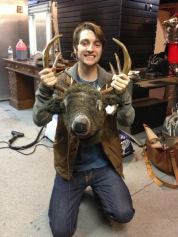 NS: As a fan of Carpenter’s The Thing, I always enjoy and appreciate the comparisons. Though, I was somewhat surprised when just about everyone started to make them, not that The Thing wasn’t one of the film’s inspirations, it was, but there are so many other films that I feel have more in common, and were heavier influences. I think The Shining was my biggest influence in coming up with the idea and writing the script. After watching it for the 100th time, I remember thinking to myself, “I wish there were more films like this.” I love the mystery of The Shining, and how masterfully Kubrick was able to tell the story behind the scenes. There’s always something happening that we’re not seeing – or that we just catch glimpses of – and we don’t realize it until we see the plot beginning to unfold. Eyes Wide Shut is an even better example of how good Kubrick was at this kind of storytelling. That was the kind of film I wanted to make.
NS: As a fan of Carpenter’s The Thing, I always enjoy and appreciate the comparisons. Though, I was somewhat surprised when just about everyone started to make them, not that The Thing wasn’t one of the film’s inspirations, it was, but there are so many other films that I feel have more in common, and were heavier influences. I think The Shining was my biggest influence in coming up with the idea and writing the script. After watching it for the 100th time, I remember thinking to myself, “I wish there were more films like this.” I love the mystery of The Shining, and how masterfully Kubrick was able to tell the story behind the scenes. There’s always something happening that we’re not seeing – or that we just catch glimpses of – and we don’t realize it until we see the plot beginning to unfold. Eyes Wide Shut is an even better example of how good Kubrick was at this kind of storytelling. That was the kind of film I wanted to make.
When I sat down to outline the script, I remember saying to myself, “I want to make that kind of story, in a gritty setting more like The Thing.” Other influences worth mentioning are The Andromeda Strain, a film I saw when I was very young watching TV alone late at night, the realism that movie created with all of its “sciencey” dialogue had a very cool appeal to me. And with the slow pace of that film, I found myself investing more in the characters and their mission, whereas some films tend to skip over that stuff, and then I have a tough time caring about what happens next.
I can’t recall how I came up with the actual idea for the film’s “creature”, if you want to call it that. When I was still in high-school, I made a short film called “The Goatman” which is long-lost, possibly on the Internet somewhere . I think I submitted it to an on-line film festival with DVXUser, and it came 29th out of 30 entries. “The Goatman” was about a guy who wakes up early one morning and everyone is gone – his parents, his brother, his neighbors, everyone. In case things aren’t bad enough, he’s snowed in and his car won’t start. As he’s trying to piece together where everyone went, he realizes there’s someone, or something, following him around. I don’t think there was much resolution or explanation in the end, but the creature was a goat who walked around on his back legs.
LE: I wouldn’t presume to speak for others but I know for myself the reason why I first thought of The Thing was you had such a great ensemble cast working within a close, isolated environment. When I think of The Thing that’s what first comes to mind before anything else. With Black Mountain Side I was impressed first of all in the writing in that these characters stood out. I was never confused as to who they were later in the film, yet they were not stereotypes. Second of all, the actors you found did a wonderful job with the material at hand. How involved of a process was it finding these actors?
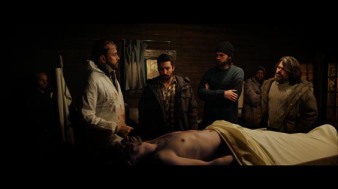 NS: Finding the actors was shockingly easy. Most of them were friends of mine, who I had worked with previously. Andrew Moxham (Doc), Shane Twerdun (Jensen), and Steve Bradley (Welles) were all coworkers of mine at the Vancouver Film School, where I was a Teacher’s Assistant for about two years. I had seen Shane act in an indie feature that I worked on as a boom operator (Two Married People) and I thought he was great. I had seen Steve and Andrew act in a few things, and thought they would fit the role. Timothy Lyle was a friend of mine, who I’d directed in a few shorts with the Vancouver Film School. Carl Williams (Francis Monroe) was a student at the Vancouver Film School while I was working there, and one day I was running camera for an improv exercise and he came in and just blew all the other students out of the water. Everyone was shocked at his acting talent that day, so he was an easy cast. In the end, we only really had to cast Gyles and the Professor through auditions, and we lucked out in finding Marc Anthony Williams and Michael Dickson (respectively) on day one of casting.
NS: Finding the actors was shockingly easy. Most of them were friends of mine, who I had worked with previously. Andrew Moxham (Doc), Shane Twerdun (Jensen), and Steve Bradley (Welles) were all coworkers of mine at the Vancouver Film School, where I was a Teacher’s Assistant for about two years. I had seen Shane act in an indie feature that I worked on as a boom operator (Two Married People) and I thought he was great. I had seen Steve and Andrew act in a few things, and thought they would fit the role. Timothy Lyle was a friend of mine, who I’d directed in a few shorts with the Vancouver Film School. Carl Williams (Francis Monroe) was a student at the Vancouver Film School while I was working there, and one day I was running camera for an improv exercise and he came in and just blew all the other students out of the water. Everyone was shocked at his acting talent that day, so he was an easy cast. In the end, we only really had to cast Gyles and the Professor through auditions, and we lucked out in finding Marc Anthony Williams and Michael Dickson (respectively) on day one of casting.
Of all of my horror pet peeves, stereotypes take the cake. To me, there is nothing more annoying than “stoner guy”, “slutty girl”,”creepy kid”, or “creepy old lady”. I always try to avoid these stereotypes when approaching any script, Black Mountain Side was no different. But sometimes they’re very hard to avoid because they’re practically ingrained in our culture. An early draft of Black Mountain Side had a ghostly old woman come to visit Jensen every night. It was supposed to be another incarnation of the deer creature that visits the rest of the group. But in a later draft, I chose to remove it because I felt it was just cashing in on an overused stereotype. Also in the first draft, the native workers that are on the site weren’t able to speak English, and Gyles was originally supposed to be on site as a translator. But in a later draft, I decided to make them English-speaking, seeing as I’d never met a non-English speaking aboriginal in Canada. I’m not sure why, but stereotypes just have a way of seeping into a script. I mean, in all of my efforts to stray away from them, we still ended up with a cat as the first victim! (My own cat, Fleetwood, by the way.)
LE: Circling back for just a bit, you mentioned loving Andromeda Strain for its atmosphere of realism the film conveyed with its dialogue. My wife is a photographer whose particular passion is megalithic ruins. For our honeymoon we went to Machu Picchu. Not to give away plot points in Black Mountain Side, when it reached the section concerning the Clovis people she was right there with you. Was this an area of interest for you prior to working on the script for Black Mountain Side or was this special research you took on just for this project?
NS: I’ve always wanted to go to Machu Picchu. Maybe one day…
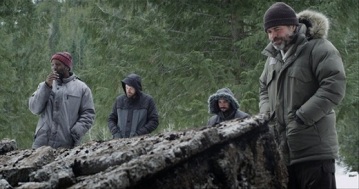 I studied archaeology for a few years at the University of Calgary, and even took a class specifically on South American archaeology. I was always interested in the mystery of how humans got to the Americas, and my professors always had different theories. I thought it would be cool to have the plot of Black Mountain Side revolve around a crew of archaeologists on the verge of solving that mystery. But at the same time, I wanted to create my own mythology, and I wanted to leave as much open to the audience imagination as possible, with enough clues to tease a grand solution – let people know that if they do the work, and watch closely enough, they can solve the mystery. And in a way, that’s the appeal I see in archaeology.
I studied archaeology for a few years at the University of Calgary, and even took a class specifically on South American archaeology. I was always interested in the mystery of how humans got to the Americas, and my professors always had different theories. I thought it would be cool to have the plot of Black Mountain Side revolve around a crew of archaeologists on the verge of solving that mystery. But at the same time, I wanted to create my own mythology, and I wanted to leave as much open to the audience imagination as possible, with enough clues to tease a grand solution – let people know that if they do the work, and watch closely enough, they can solve the mystery. And in a way, that’s the appeal I see in archaeology.
So when it came to writing the script, I just drew from my own schooling, and I filled the gaps by making some stuff up. It’s also worth mentioning that, in Canada, schools spend an outrageous amount of time teaching kids about Clovis people and general aboriginal history and we had plenty of field trips to museums filled with Clovis points. Working it all into the script was a fairly straight forward process.
What I found interesting, during the filmmaking process, was Carl Toftfelt’s approach to researching his role as Francis Manro, the camp’s head researcher. Carl is from Sweden with no background in archaeology, so he came into the role with a blank slate. He watched hours of lectures online, and he even borrowed my old university textbooks and read the damned things, even I had never read them! When he returned them, they were well-used and filled with sticky notes. It was funny, on set he was correcting my mispronunciation of certain terms and showing the art department and other actors how to properly handle the (Styrofoam) artifacts. Carl, by the way, is a tremendous actor.
LE: Okay, that is seriously cool. It is hard to single out any one member of your cast because I would not stop until I had named each and every one of them. When I’ve told people about Black Mountain Side I’ve been saying it’s probably one of the most adroit uses of cosmic horror I’ve seen in film. I ask this question of nearly everyone I interview for Lovecraft eZine, what does the term cosmic horror mean to you?
NS: Thank you very much. Cosmic horror, to me, means horror on an existential scale. It’s not being afraid of what’s around the corner, but being afraid of what’s out there, what we don’t understand (or can’t understand) being afraid of what happens after we die, or what seemingly impossible things might not be so impossible.
If I’m going to be honest, I’d never actually heard the term “cosmic horror” until after we started promoting Black Mountain Side. People started approaching me and saying similar things to what you just said, that it was an excellent example of cosmic horror. I just thought “That’s neat!” until I started hearing it over and over and I realized there was a whole fan base devoted to it! And as I did more research, I realized “cosmic horror” was no different from what I had been calling “existential horror”. A lot of filmmakers/writers/artists/storytellers get cosmic/existential horror wrong. I think a lot of people are missing the point. Too many people go and try to recreate what other successful artists did, without first trying to figure out what it was those successful artists did in the first place. I’m always seeing these Lovecraft adaptations popping up on my Twitter feed, but they make the same mistake. They think: Tentacles! Big monsters! Ancient beings! But no one ever stops to figure out why those things were so successful for Lovecraft. They just recreate it, and it goes nowhere. If you want to make cosmic horror, you need to be like a 4-year old child, and ask “why” over and over and over. Why was that movie scary? Because they were being chased by a monster. Why is that scary? Because the monster will kill them. Why is that scary? Because they don’t want to die. Why is that any scarier than every other horror movie? You have to keep asking and boil it down until it’s very clear. Cthulhu is frightening because of what his existence means to humankind, not because of his tentacles or his size or his age. He makes us feel existentially small and unimportant. That’s what’s scary about Cthulhu, but people miss that. They just think: Tentacles! Big monsters! Ancient beings! If you ask me, I think you can have the same impact with a deer.
LE: Agree wholeheartedly and I believe that was one of the main reasons I reacted to your film so strongly, it walked a mythology of its own. Have you by any chance read Eugene Thacker’s trilogy The Horror of Philosophy? What literary influences do you hold dear?
NS: I have not read any of Eugene Thacker’s work but it sounds interesting so perhaps I’ll check it out.
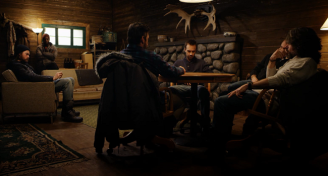 Going into Black Mountain Side (writing the script back in… 2011/2012), I’ll confess that I wasn’t much of a reader. I couldn’t get a book to hold my attention for more than five minutes to save my life. Though, since shooting Black Mountain Side (with the help of some ADHD meds) I’ve been more of a reader. I’ve tried reading horror, but found that horror literature had a lot of the same problems I have with modern horror films, lots of tropes, uninspired, etc, etc. It seems like, even in the world of literature, everyone is just trying to be “scary” and it gets old fast. I do like the idea of a horror novel, so I’ll probably give it another go sometime soon.
Going into Black Mountain Side (writing the script back in… 2011/2012), I’ll confess that I wasn’t much of a reader. I couldn’t get a book to hold my attention for more than five minutes to save my life. Though, since shooting Black Mountain Side (with the help of some ADHD meds) I’ve been more of a reader. I’ve tried reading horror, but found that horror literature had a lot of the same problems I have with modern horror films, lots of tropes, uninspired, etc, etc. It seems like, even in the world of literature, everyone is just trying to be “scary” and it gets old fast. I do like the idea of a horror novel, so I’ll probably give it another go sometime soon.
Not so relevant, but I have been reading a lot of Vonnegut and Bukowski and Thompson. I like how they can tell interesting stories and create interesting characters in very few words. I think that’s my problem with writers like Stephen King and Dan Simmons, their books are so long-winded and drawn out. I can appreciate a slow-burn film, at least that only takes one sitting. But I read that Simmons novel, Drood, and it must have taken me six weeks to finish. The book was okay. More than anything, it was a good exercise in discipline.
These days I’m finding myself interested in the strangest things. I read weird non-fiction books. I recently read one called Who Built The Moon which was one of the more absurd things I’ve read, or how-to guides for skills I have no intention of pursuing. I think my issue with fiction is that I immediately start to think about how I would write whatever I’m reading differently, and then I just start thinking about things I want to be writing and the next thing I know, I’m five chapters into the book but I can’t remember anything beyond the first page. I think that’s why I like crap like Who Built The Moon, it’s absurd enough to hold my attention.
LE: I find your answer fascinating because Black Mountain Side runs parallel to works by contemporary writers. So much so that I wish to pile your arms high with books yet at the same time the fact you’ve arrived at such a similar space without outside influence is delightful and seeing where you will take it from here is an utterly alluring prospect. With that in mind I will suggest Nuzo Onoh. I feel you’ll find her ability to create compelling characters and tell engrossing stories succinctly will intrigue you. The other recommendations would be Charles Willeford’s Burnt Orange Heresy and Victoria Nelson’s Secret Life of Puppets, a non-fiction book. On that note, uber-geeky question here. In the film credits Brandon Peterson and Sabia Kular are listed as puppeteers. I loved the subtlety during those scenes. I was frequently asking my wife, “Do you see something right over there?” Just to ensure my eyes weren’t playing tricks with me. I see from IMDB that Kular’s other credit is as a costume designer on “Charlotte’s Song” and with Peterson I could find nothing, which I found curious. How much was prearranged and how much was worked out on set? I don’t believe I’m revealing a single thing here by saying the vocal work by Nathanial Gordon was magnificent. Was that done in post and if so what did the actors have to work with on set?
NS: Thanks for growing my already massive reading list!
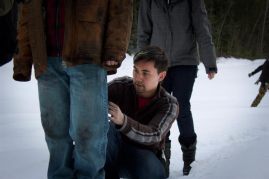 Brandon and Sabia were the “puppeteers” because no one else would stand up to the plate, or I should say, no one else had the time. They were the costume designers, one of the very few positions on set that had downtime while we were actually filming. The fellow who made the deer puppet didn’t tell us until we were on set that the thing needed 2-3 people to operate, or that he would be too busy to be one of those 2-3 people. So throughout filming, we had many different crew members operate the thing. It was Sabia and Brandon more often than not, so they were awarded the credit. They also helped rebuild the creature after we shot the deer scenes the first time, (initially, the deer looked ridiculous. We called it the “Cow-man”). Samantha McDonald and Matthew Barrett also helped a great deal with the deer puppet.
Brandon and Sabia were the “puppeteers” because no one else would stand up to the plate, or I should say, no one else had the time. They were the costume designers, one of the very few positions on set that had downtime while we were actually filming. The fellow who made the deer puppet didn’t tell us until we were on set that the thing needed 2-3 people to operate, or that he would be too busy to be one of those 2-3 people. So throughout filming, we had many different crew members operate the thing. It was Sabia and Brandon more often than not, so they were awarded the credit. They also helped rebuild the creature after we shot the deer scenes the first time, (initially, the deer looked ridiculous. We called it the “Cow-man”). Samantha McDonald and Matthew Barrett also helped a great deal with the deer puppet.
The filming actually went fairly smoothly, special effects aside. Long story short, the guy we hired to originally do the effects lied to us a bunch and had pretty much nothing ready come time to shoot. So we were scrambling while on location to get things finished and looking half-decent. For the studio shoot which happened a month after the location shoot, we brought on Tom Sosnowski for the special effects, and he was a hero. He had everything ready and it all looked great. He’s the man behind the ax amputation scene. He’s actually going to be doing the effects for Hammer of the Gods, our next special effects heavy film. I was surprised when he signed on for another shoot. He thinks I’m a lunatic because I insisted the actors use a real ax for the amputation scene while Tom was hiding under the operating table with a blood pump, and because I insisted on shooting the whole scene in one shot leaving quite literally no room for error. We got it though, so I don’t know what the big deal was.
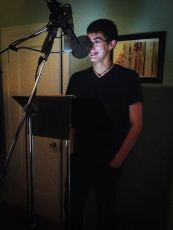 Nathanial Gordon is another hero who came out of nowhere. Go and dig up his voice-acting demo reel and your mind will be blown. The man can make any voice/noise/anything come out from his mouth. Even our sound designer, Mark Dolmont, was baffled by how talented he is. After we finished recording the creature voices, out of nowhere, he started to make wind noises with his throat — and Mark Dolmont ended up using Nathan’s wind noises in the cut.
Nathanial Gordon is another hero who came out of nowhere. Go and dig up his voice-acting demo reel and your mind will be blown. The man can make any voice/noise/anything come out from his mouth. Even our sound designer, Mark Dolmont, was baffled by how talented he is. After we finished recording the creature voices, out of nowhere, he started to make wind noises with his throat — and Mark Dolmont ended up using Nathan’s wind noises in the cut.
I think he found our post on Craigslist of all places, when we were just starting post-production. Originally, I had planned to have the deer voice be a “calming voice”. But when Nathan emailed us, he attached a number of different versions, including the grungy voice that was used in the film. There are no effects added to that voice. No word of a lie — that was the noise that came from his mouth. He will also be doing some creature work on Hammer of the Gods.
Because of the way the shooting schedule worked out, Tim Lyle (Drew McNaughton) had his first scene on day one of shooting, then didn’t have another scene until the second week of shooting. And because we were so far from home, he decided to just hang out on set while we shot (the cabins in the film were also the cabins we lived in while shooting). He was bored, so he did the on-set creature voice for the other actors. He was also the only actor who conquered the game you see Shane Twerdun (Myles Jensen) playing at the start of the film (a game which I programmed when I was fifteen years old). I think, by the end of the shooting, Tim was actually feeling some of the cabin fever his character feels in the film.
LE: When I watched the film a second time the sound design fascinated me, it’s almost as if it provides auditory clues of what lies ahead yet it’s subtle, rather like your use of the effects that has the audience asking, “Do you see something over there?” How did you find Mark Dolmont and how did the two of you work on the film’s approach to sound?
 NS: Mark Dolmont was a friend and frequent collaborator of our editor, James Barrett. James recommended him, and we looked into his work and liked what we heard — another instance of things conveniently falling into place. Mark is phenomenal at what he does and he’s incredibly passionate, which makes him a treat to work with. I always find that passionate people are always the best to work with, and strangely, sound people are always the most passionate.
NS: Mark Dolmont was a friend and frequent collaborator of our editor, James Barrett. James recommended him, and we looked into his work and liked what we heard — another instance of things conveniently falling into place. Mark is phenomenal at what he does and he’s incredibly passionate, which makes him a treat to work with. I always find that passionate people are always the best to work with, and strangely, sound people are always the most passionate.
Sound is an art of subtleties, and it’s impossible to fully appreciate unless you work in sound. Even then, it’s hard to fully appreciate. It’s a fascinating art too, because the better the sound work, the less you will notice it, but the more you will feel its effects. Black Mountain Side is an orchestra of creaks and wood-groans and footsteps crunching in the snow and echoing mountainscapes.
I worked in the sound department for a long time before making Black Mountain Side and continued working in sound for a while afterwards as well, so I was very picky when it came to the sound design. Even before I finished my big rant with Mark, during in our first meeting, he knew what I wanted. He was on the same wavelength instantly. It goes without saying that he’ll be working on the next film as well. It helped that Adam Pisani’s location sound was near-flawless, giving Mark a ton of freedom to focus on the design rather than ADR and dialogue editing.
LE: What was it like filming in those locations for Black Mountain Side? And what special challenges/considerations are inherent in being a Canadian film maker? What was it like for you raising financing for this project?
NS: With the exception of a couple of days in studio, we shot all of Black Mountain Side on a mountain property near a town called Lumby. We lived in the same location (in the cabins you see in the film) so there was no driving to set each morning, which made shooting a lot more manageable, in my opinion. There was no Internet or cell reception, which was kind of nice because there were hardly any distractions. The weather was actually quite nice, too nice at times, because the snow was melting!
As for challenges in being a Canadian filmmaker, that’s hard to answer because I don’t have anything to compare it to. I don’t know that there are any specific challenges being Canadian. If anything, there are lots of benefits. There are tons of great locations, lots of epic wilderness, people are super nice, etc, etc. Telefilm (which we did not use for Black Mountain Side) is a Canadian entity which is incredible for indie filmmakers. There are tons of great resources up here.
Samantha McDonald, our executive producer, handled the financing for Black Mountain Side. She was the one who went out and found the investors and did all of the sweet-talking. It was easy for me because I could just focus on the filmmaking process.
LE: You’ve mentioned your next project will be entitled Hammer of the Gods and that it will be an effects heavy feature. Is there anything else that you can share with us about it?
NS: I can’t say a whole lot about Hammer of the Gods right now. It’s a horror, kind of in the same spirit as Black Mountain Side. It will be faster than Black Mountain Side, more action, and I guess you could say unrelenting. With Black Mountain Side, I drew inspiration from 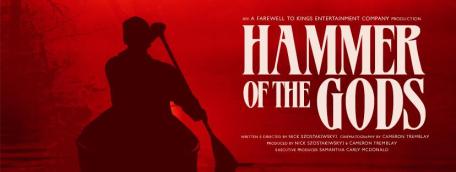 films like The Shining, Eyes Wide Shut, and Andromeda Strain. With Hammer of the Gods, I’ve been watching films like Alien and The Evil Dead. But I’m still trying to tap into that “cosmic horror” (as the Lovecraft crowd likes to call it) that people seem to love about Black Mountain Side. We’ll be shooting this summer, and I’ll be posting as much as I can on Twitter. I’m trying to be better with social media.
films like The Shining, Eyes Wide Shut, and Andromeda Strain. With Hammer of the Gods, I’ve been watching films like Alien and The Evil Dead. But I’m still trying to tap into that “cosmic horror” (as the Lovecraft crowd likes to call it) that people seem to love about Black Mountain Side. We’ll be shooting this summer, and I’ll be posting as much as I can on Twitter. I’m trying to be better with social media.
Hammer of the Gods is going to be a creature feature, all practical (no CGI). Just yesterday, we got the finished creature designs back from our concept artist. I’m pretty excited about it — I’m not sure anything like this has been done before. All I can say is, I have a feeling this is going to be a memorable movie!
LE: Now that sounds cool and given how much I enjoyed Black Mountain Side I am definitely looking forward to seeing it. Nick on behalf of Lovecraft eZine I’d like to give a very heartfelt thanks for a fascinating interview and personally for giving me 1) a great film to look forward to and 2) a talented director’s career to watch unfold. Thanks for taking the time out of your busy schedule and I eagerly look forward to seeing Hammer of the Gods.
NS: Thanks so much! I thoroughly enjoyed answering your questions, so it’s my pleasure. Again, I’m glad you enjoyed Black Mountain Side and I hope you will like Hammer of the Gods!
(Rent or purchase Black Mountain Side.)
This interview was conducted by Acep Hale.


Ha! I’ve picked up this just by the title. After a while I was sure this has something Lovecraftian in it. I was not disapointed. Then looking about the movie I found about it here. I was right. Tehhehehhe.
LikeLike
Loved Black Mountain Side. Reviewed it on my blog back in March (review has spoilers in the off chance anyone goes over to read it). It handles cosmic horror and group dysfunction cleverly and intelligently. Makes some classically Lovecraftian moves, specifically the ideas that either there is no answer, or the answer is madness.
LikeLike
Wow, I guess we weren’t watching the same movie, because Black Mountain Side was a big bunch of nothing, in our opinion!
LikeLike
Morning of July 3. All last night gun-shots, cherry bombs, and larger firecrackers kept me awake in the near ghetto neighborhood that I live in. This morning I made the mistake of watching BLACK MOUNTAIN SIDE. I will be honest, my state of mind was not the best to begin with… I stopped drinking a week ago and even though I did not get the shakes I have felt kind of hollow inside. So up all night and semi alcoholic withdrawal… I was ready to be entertained but instead just got creeped out… like some-one was scratching a nail along my last nerve.
The film seemed too long – but perhaps that contributed to my jumpiness and unease. I generally prefer some type of definitive answers at the end of a horror film. Maybe I missed it but all I am left with is the horrendous mind-altering bacteria from the neo-lithic era. Why the infected men should all hallucinate a deer-like entity is beyond me, although I can accept the fact that they all felt something invading their bodies. In closing, I would watch another film by this writer/director, but the second one might be my last.
LikeLike
The wife and I just watched BLACK MOUNTAIN SIDE this evening and we thought it was one of the slowest, most boring films we’ve ever seen. Sorry.
LikeLike